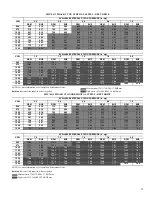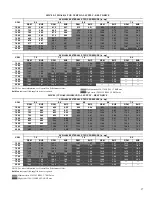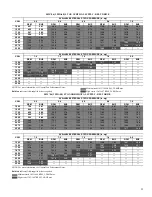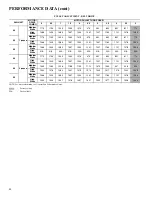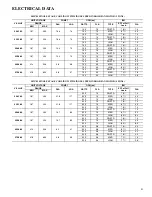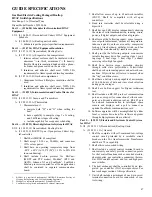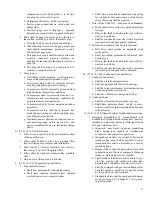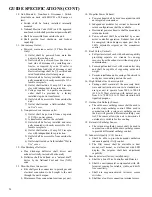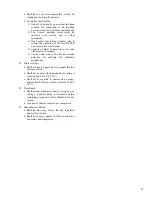
49
5. Unit shall be field convertible from vertical to hori-
zontal airflow on all models. No special kit
required.
6. Unit shall be capable of mixed operation: vertical
supply with horizontal return or horizontal supply
with vertical return.
F. (23 81 19.13.F) Electrical Requirements
1. Main power supply voltage, phase, and frequency
must match those required by the manufacturer.
G. (23 81 19.13.G) Unit Cabinet
1. Unit cabinet shall be constructed of galvanized
steel, and shall be bonderized and coated with a
pre-painted baked enamel finish on all externally
exposed surfaces.
2. Unit cabinet exterior paint shall be: film thickness,
(dry) 0.003 inches minimum, gloss (per ASTM
D523, 60°F /16°C): 60, Hardness: H-2H Pencil
hardness.
3. Evaporator fan compartment interior cabinet insula-
tion shall conform to AHRI Standards 210/240 min-
imum exterior sweat criteria. Interior surfaces shall
be insulated with a minimum
1
/
2
-in. thick, 1 lb den-
sity, flexible fiberglass insulation, neoprene coated
on the air side. Aluminum foil-faced fiberglass insu-
lation shall be used in the gas heat compartment.
4. Base of unit shall have a minimum of four loca-
tions for thru-the-base gas and electrical connec-
tions (factory-installed or field-installed), standard.
5. Base Rail
a. Unit shall have base rails on a minimum of
2 sides.
b. Holes shall be provided in the base rails for rig-
ging shackles to facilitate maneuvering and
overhead rigging.
c. Holes shall be provided in the base rail for mov-
ing the rooftop by fork truck.
d. Base rail shall be a minimum of 16 gage thickness.
6. Condensate pan and connections:
a. Shall be a sloped condensate drain pan made of
a non-corrosive material.
b. Shall comply with ASHRAE Standard 62.
c. Shall use a
3
/
4
-in. 14 NPT drain connection,
possible either through the bottom or side of the
drain pan. Connection shall be made per manu-
facturer’s recommendations.
7. Top panel:
a. Shall be a single piece top panel on all sizes.
8. Gas connections:
a. All gas piping connecting to unit gas valve shall
enter the unit cabinet at a single location on side
of unit (horizontal plane).
b. Thru-the-base capability
1) Standard unit shall have a thru-the-base
gas-line location using a raised, embossed
portion of the unit basepan.
2) Optional, factory approved, water-tight
connection method must be used for thru-
the-base gas connections.
3) No basepan penetration, other than those
authorized by the manufacturer, is permitted.
9. Electrical connections
a. All unit power wiring shall enter unit cabinet at
a single, factory prepared, knockout location.
b. Thru-the-base capability
1) Standard unit shall have a thru-the-base
electrical location(s) using a raised,
embossed portion of the unit basepan.
2) Optional, factory approved, water-tight
connection method must be used for thru-
the-base electrical connections.
3) No basepan penetration, other than those
authorized by the manufacturer, is permitted.
10. Component access panels (standard)
a. Cabinet panels shall be easily removable for
servicing.
b. Unit shall have one factory installed, tool-less,
removable, filter access panel.
c. Panels covering control box, indoor fan, indoor
fan motor, gas components (where applicable),
and compressors shall have molded composite
handles.
d. Handles shall be UV modified, composite. They
shall be permanently attached, and recessed into
the panel.
e. Screws on the vertical portion of all removable
access panel shall engage into heat resistant,
molded composite collars.
f. Collars shall be removable and easily replace-
able using manufacturer recommended parts.
H. (23 81 19.13.H) Gas Heat
1. General
a. Heat exchanger shall be an induced draft
design. Positive pressure heat exchanger
designs shall not be allowed.
b. Shall incorporate a direct-spark ignition system
and redundant main gas valve.
c. Gas supply pressure at the inlet to the rooftop
unit gas valve must match that required by the
manufacturer.
2. The heat exchanger shall be controlled by an inte-
grated gas controller (IGC) microprocessor.
a. IGC board shall notify users of fault using an
LED (light-emitting diode).
b. The LED shall be visible without removing the
control box access panel.
c. IGC board shall contain algorithms that modify
evaporator fan operation to prevent future
cycling on high temperature limit switch.
d. Unit shall be equipped with anti-cycle protec-
tion with one short cycle on unit flame rollout
switch or 4 continuous short cycles on the high

